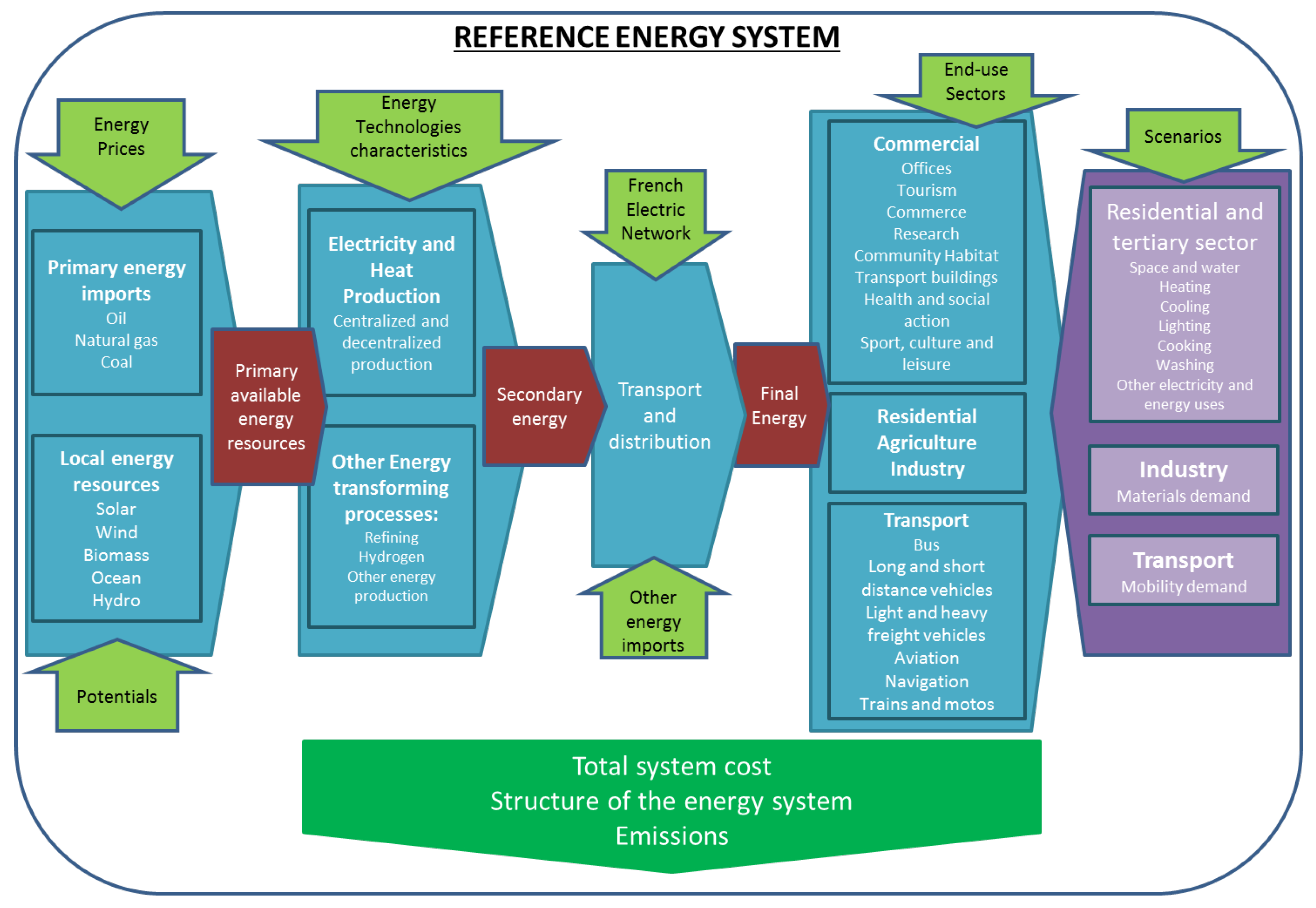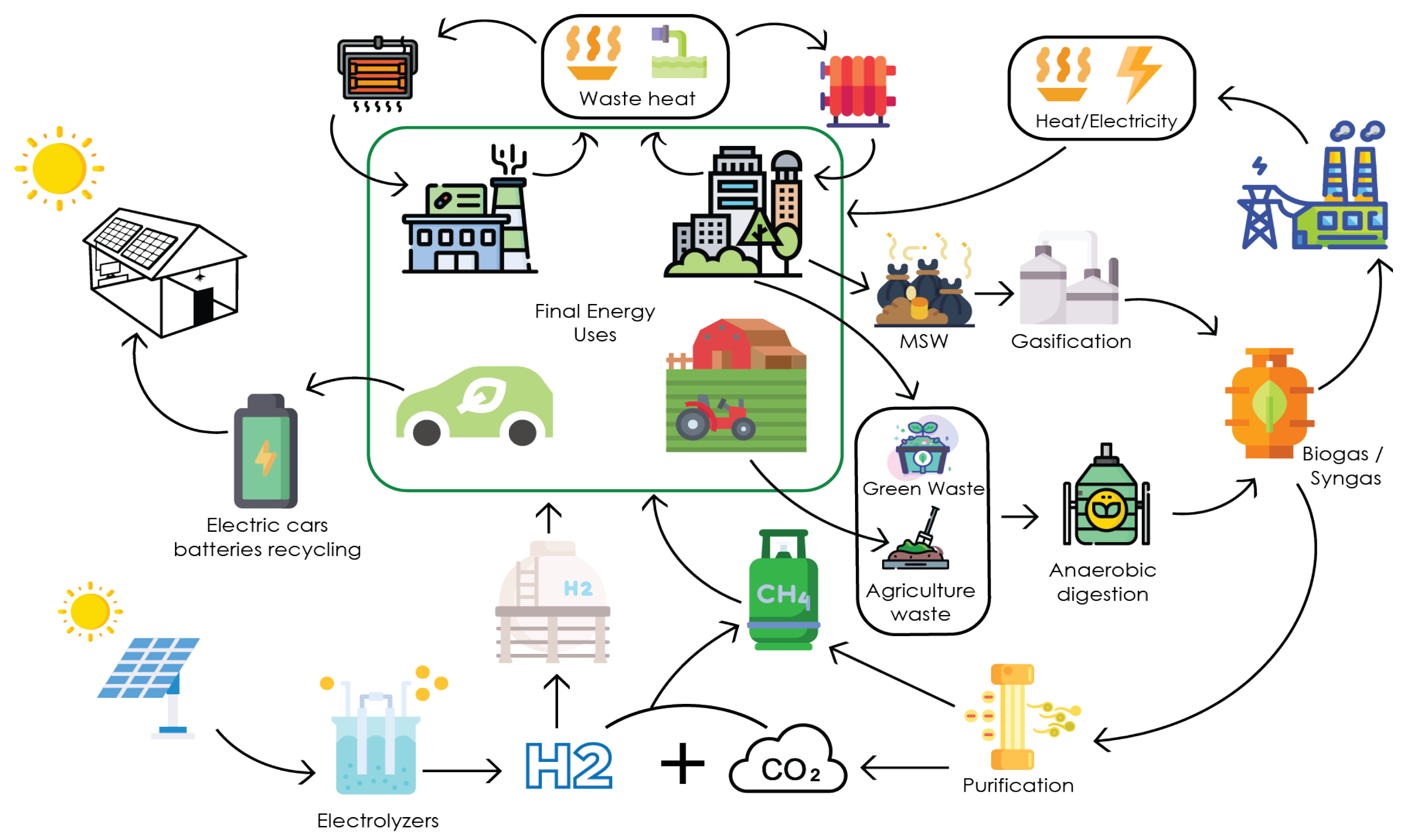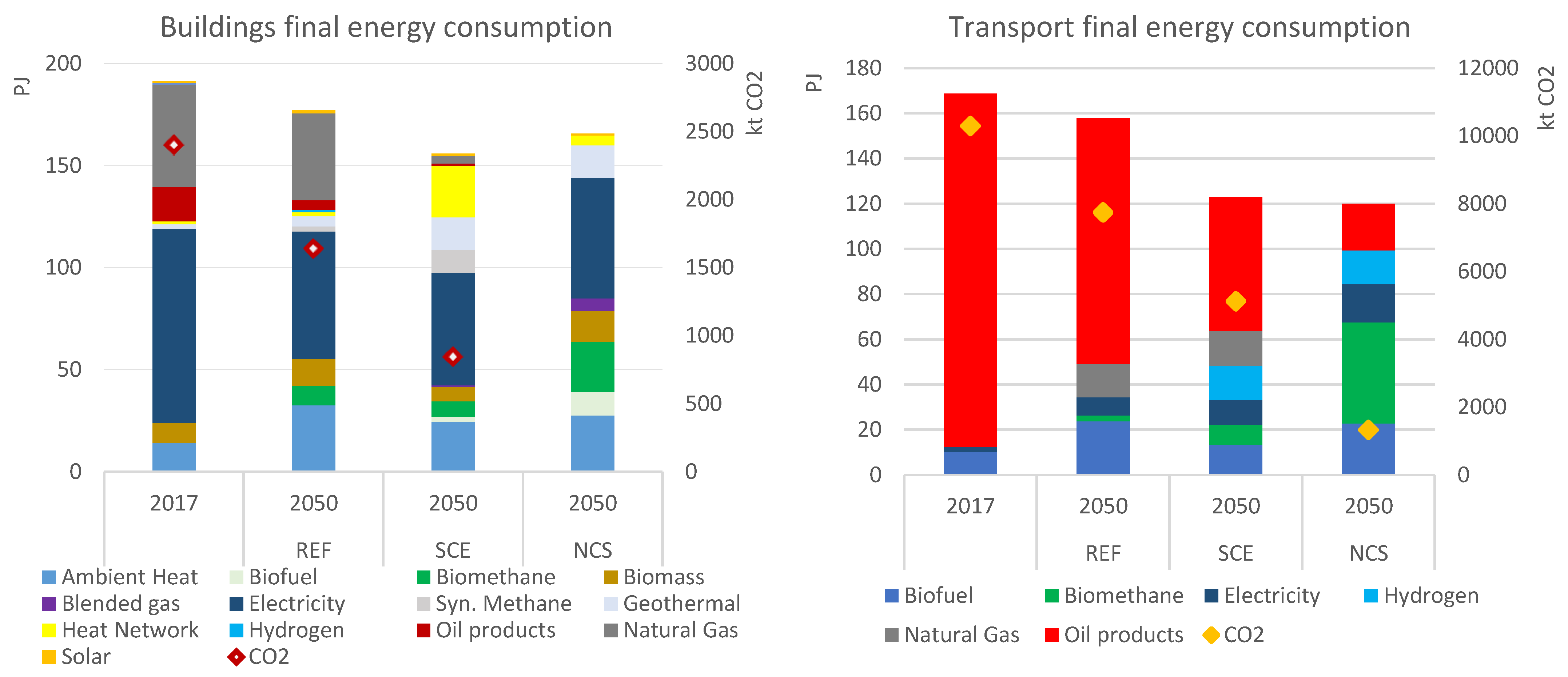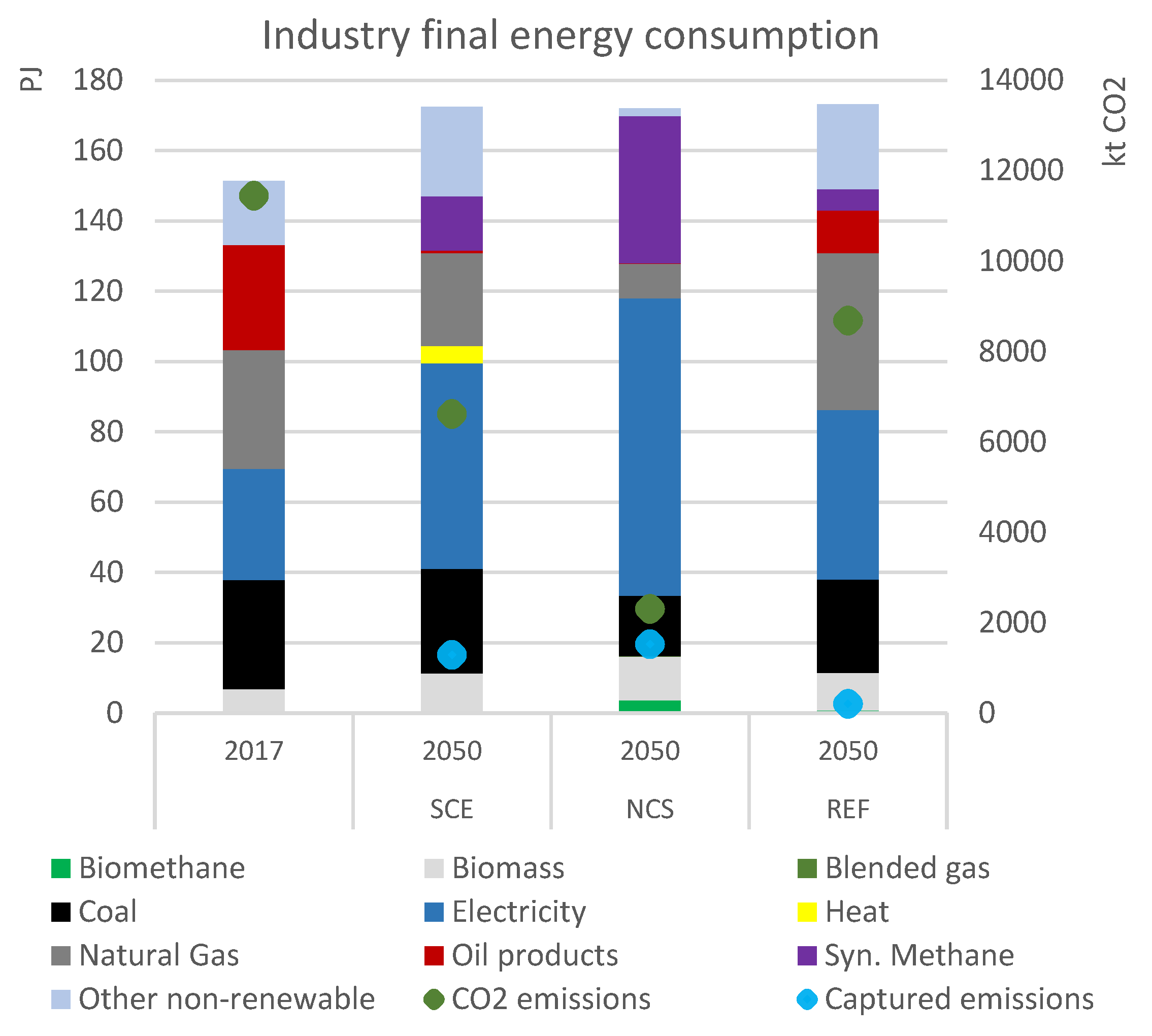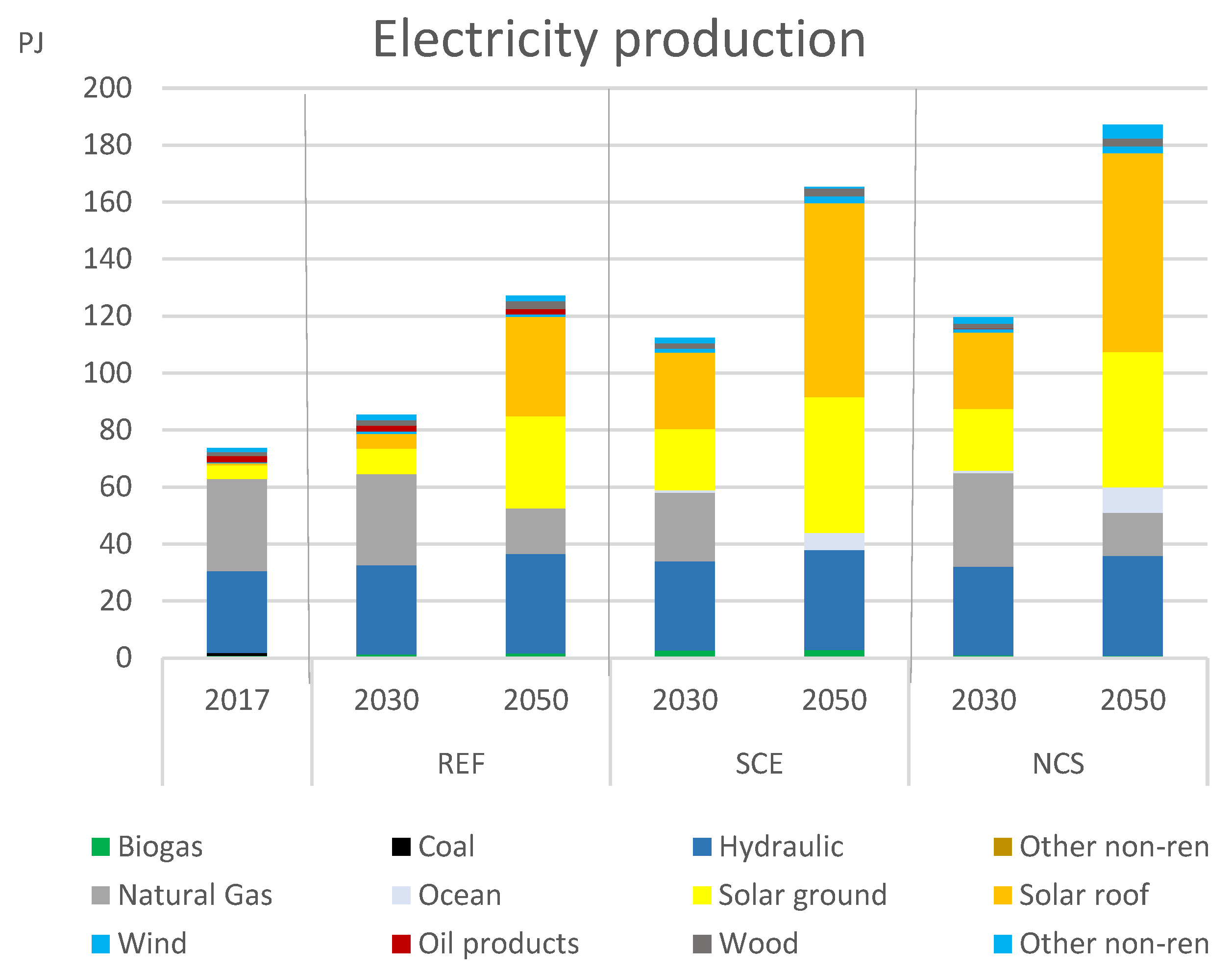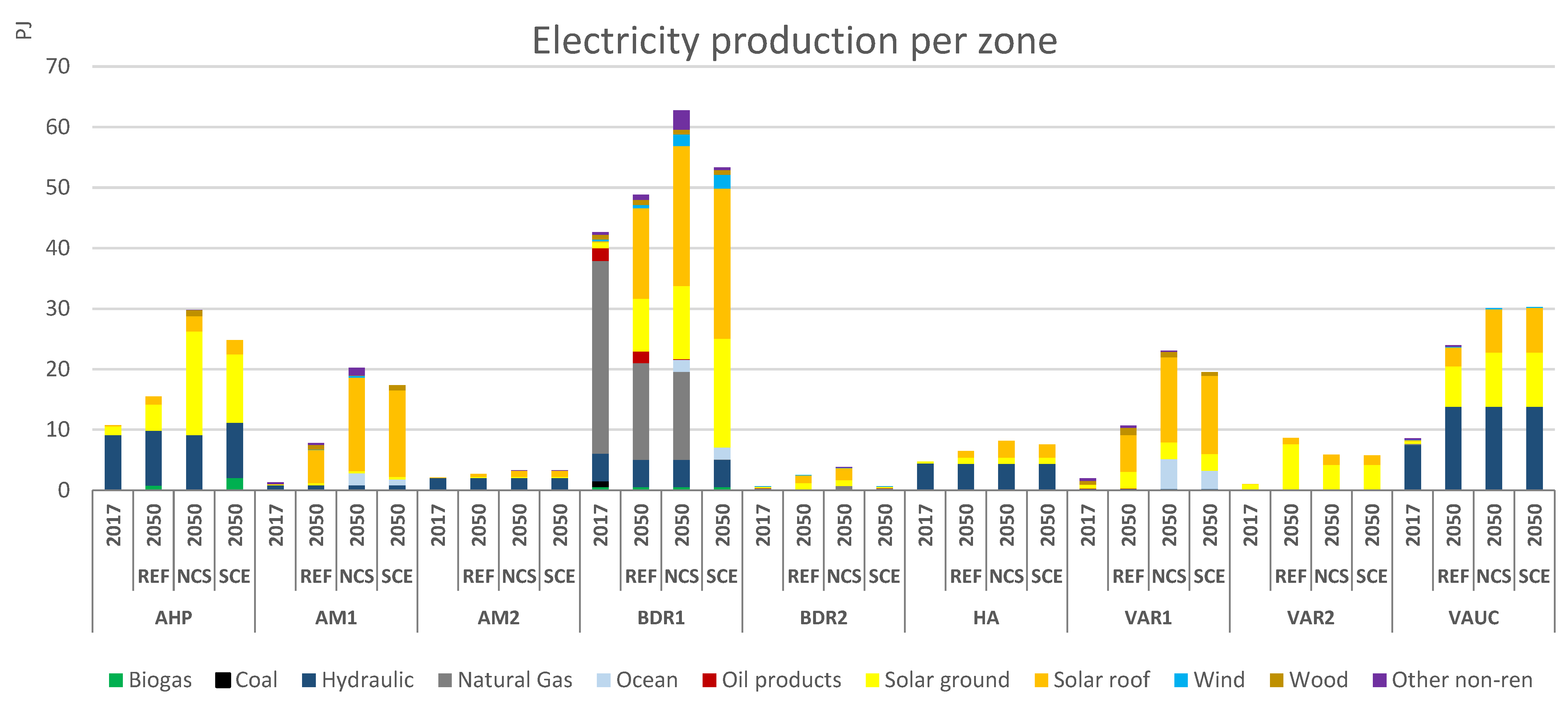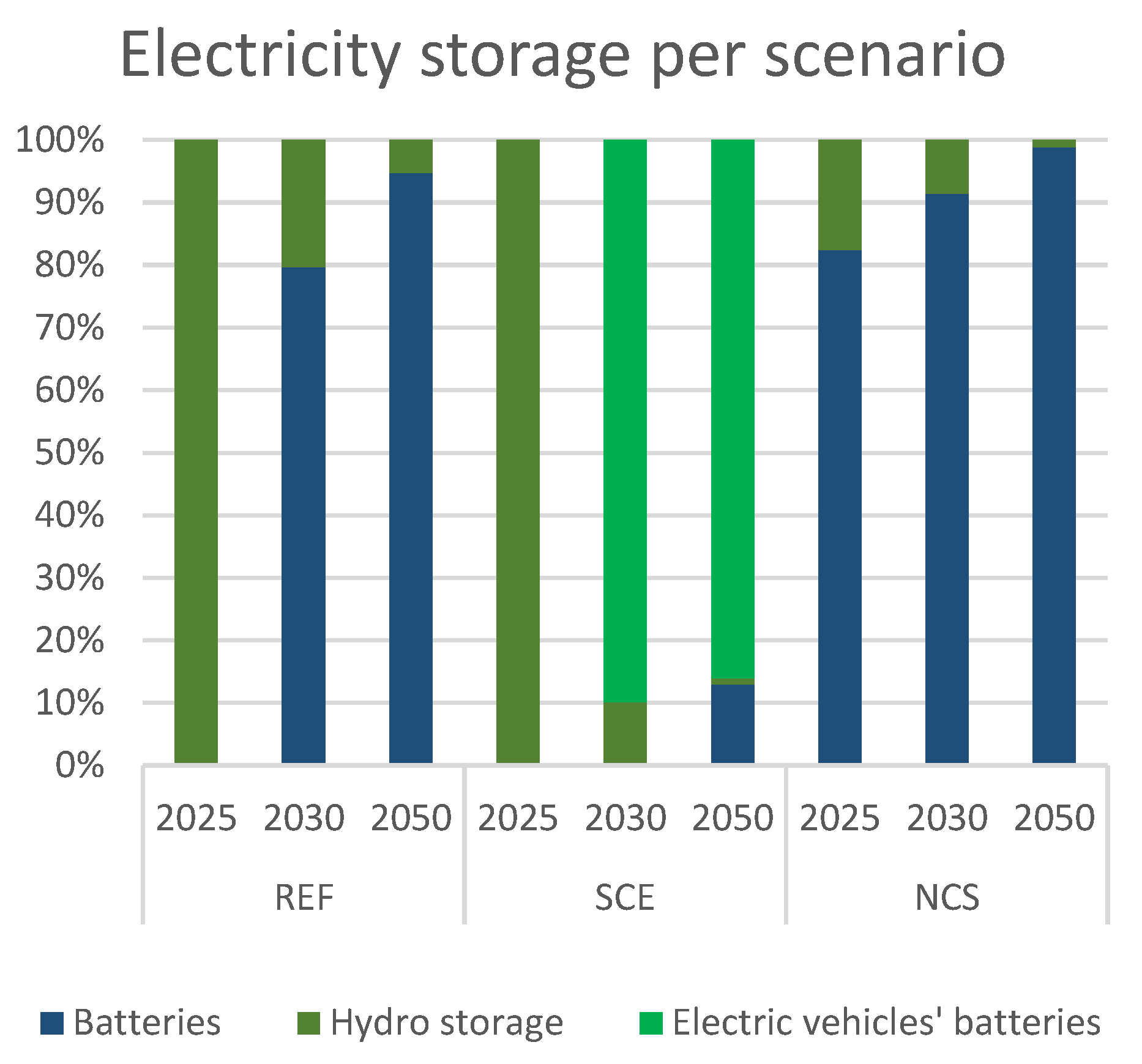1. Introduction
The circular economy (CE) concept is still under theoretical construct, but it can be defined as “An
economic system whose main objective is to contribute to sustainable development (meeting current needs without compromising those of tomorrow), dissociating economic growth from environmental impact and social inequality. This involves
redesigning how society consumes and produces and how it interacts with the environment and with society itself via innovative business models and a sustained public policy. The deployment of a CE implies the
optimal implementation of the 4 Rs, namely “reduce, reuse, recycle, and recover”. This approach aims to minimize resource consumption, applying a systemic strategy at the micro (businesses and households), meso (industrial collaborations, regional initiatives), macro (national and global contexts), and supply chain levels (interactions between previous levels) [
1]”. A CE approach seeks to minimize resource consumption and extend the lifespan of materials, promoting efficiency and innovation while considering a systemic perspective [
2,
3,
4,
5]. A CE endeavors to shift the perception of waste to that of a resource that can be reintegrated into the production cycle or returned to the environment in a way that aligns with natural systems, thereby contributing to sustainability [
6,
7]. Consequently, a CE emerges as a promising solution to address resource scarcity and climate change by prioritizing sustainable practices.
The implementation of a circular economy perspective can be a valuable strategy to address climate issues [
2,
3]. In fact, the low-carbon energy transition aims to reduce the environmental impact of energy production and consumption by increasing resource efficiency, reducing energy consumption, and shifting to the use of renewable resources [
8]. This perfectly aligns with the CE philosophy [
9]. Moreover, a CE can ensure the supply of energy in a sustainable way by maximizing the use of local resources, for example, via energy recovery [
10]. This can contribute to energy security and reduce risks related to geopolitical issues and resource depletion, which is also an objective of the low-carbon energy transition. Consequently, CE and energy transition are inherently intertwined [
11].
Different initiatives have been explored from a CE perspective to recover energy from resources that would have otherwise been buried or disposed of. One of the most researched options is the recovery of energy from municipal solid waste (MSW), given the increasing production of waste in urban areas [
12]. Burning MSW allows for the recovery of heat and electricity, which helps manage waste and meet rising energy demand [
3,
13]. However, waste incineration should ideally be the last resort, as it produces atmospheric pollutants and destroys materials, requiring new resources [
13,
14]. Gasification of MSW or wastewater sludge (WWS) is another method of energy recovery that can produce synthetic gas (syngas) [
15]. Syngas typically contains carbon monoxide (20–30%), hydrogen (30–45%), carbon dioxide (15–25%), nitrogen (3–5%), and methane (8–12%) [
16]. This syngas can be used directly to produce energy or can be purified (CO
2 extraction) to be injected into gas transport and distribution networks [
10,
17]. Anaerobic digestion is another process that can be used to recover energy from waste [
18,
19]. This applies to organic waste such as WWS, food waste, and biowaste from agricultural activities. In this case, biogas can be recovered and follow a similar path to syngas.
Another option for implementing a CE in the context of a low-carbon energy transition is to use CO
2 to produce other products. Methanation is one such process that enables the utilization of CO
2; when CO
2 is mixed with hydrogen, methane is produced and can be injected into the gas grid [
20]. Unused resources can be recovered from a CE perspective to achieve a low-carbon energy transition. For instance, waste heat from industrial activities or wastewater can be used to increase system efficiency by recovering unused heat via district heating networks [
21,
22,
23]. This unused heat can be transported to consumers demanding heating or used to produce electricity [
24]. Batteries from end-of-life electric vehicles can also be reused to store electricity during periods of high photovoltaic production, extending the life cycle of the batteries and allowing for greater benefits from solar production [
25,
26,
27].
As a CE presents several solutions to current environmental challenges, many policy planners have increasingly integrated it as a strategy to reach their environmental goals. In many European countries, the CE has been part of environmental policies since the end of the twentieth century [
28], and recently, it has gained further momentum with the adoption of the CE action plan by the European Commission in 2015, updated in 2020 [
29]. In France, the CE was introduced in 2015 via the LTCEV (Law for the energy transition and green growth). The objective of this law was to reduce resource wastage and to “close the loop” [
30]. At the same time, via the LTECV, France redefined its decarbonization objectives and achieved a new milestone in extending the management of its energy policy to its territories. This allows for a more shared definition of policies and objectives while granting local authorities the necessary jurisdiction to implement an energy transition for their own local energy systems [
31]. The interest in the territorialization of energy policy lies in finding complementary solutions across different sectors, such as urban planning, transport, and housing, which can lead to more dynamic actions for a rapid energy transition [
32]. Additionally, territories can adopt more precise policies based on their respective energy realities, responding to their unique challenges, mobilizing local decentralized renewable resources, and building synergies between urban and rural areas [
33]. As a result, most French territories have established new objectives for the clean development of their energy systems. The SUD PACA region in the southeast of France has, for example, set a target to achieve a circular territory and carbon-neutral energy system by 2050 via the significant development of renewable resources [
34].
Research into how the CE can help the energy transition has mainly focused on individual applications and mostly on waste to energy, including waste heat recovery, municipal solid waste to energy, biowaste to energy, etc. Recently, a few studies have started to tackle the subject of energy systems and the circular economy in an integrated manner. For example, [
35] studied the implementation of a CE for a city in China, and [
36] studied the application of a CE for the decarbonization of the residential sector. Fostering the analysis of CE in all aspects of society is crucial, first to understand the effects of its application and second to foster its implementation [
37]. Moreover, the CE should be further studied at the local level, as resource recovery potential is generally located close to high-population areas.
In this context, the objective of this research is first to study how CE can be integrated into a prospective modeling tool and, second, to observe how such a strategy can help a local area to reach its climate objectives. This analysis will therefore show how integrating a CE perspective can impact strategy for the sustainable transition of a regional energy system. Additionally, this study will demonstrate the importance of deploying sustainable energy solutions at the local scale to reach ambitious national and global decarbonization objectives. Moreover, the analysis of the energy system in the SUD PACA region could provide a basis for studying the development of sustainable energy solutions in other regions of the world with similar climate conditions and energy system configurations.
3. Results
3.1. Final Energy Demand
Final energy demand decreases in all the scenarios: −13% in the SCE scenario, −16% in the NCS scenario, and just −2% in the REF scenario. Concerning CO
2 emissions, the application of a CE contributes to a reduction of more than −50% compared to 2017 in comparison to −83% in the NCS scenario. However, the SCE scenario attains a higher reduction in CO
2 emissions (and energy consumption) in the building sector (
Figure 3) of −18% with respect to 2017, compared to −13% in the NCS scenario. This is mainly due to the increased application of building renovation (25% higher in the SCE scenario than in the NCS scenario) and the development of heat networks. The latter account for 16% of the energy used by the building sector and 60% of the region’s heating demand. This increased use of heat from the network reduces the use of biomass and ambient heat, which is the lowest use among all scenarios. The remaining use of fossil fuels in the SCE scenario corresponds to the use of gas for cooking and heating demand. These uses have been decarbonized by biomethane and blended gas in the NCS scenario. In this scenario, the heat delivered via networks has doubled compared to 2017, but this only represents almost 20% of the developments reached in the SCE scenario. Geothermal energy significantly contributes to decarbonizing the building sector in the NCS scenario and the SCE scenario, where its development has reached the upper limit of the established constraints. Heat-recovering technologies (ambient heat, geothermal, and waste heat recovery) in the SCE scenario represent around 42% of the energy consumed in the building sector (28% in the NCS scenario), covering heating, water heating, and cooling demand, which shows the important role that these energies can play in the decarbonization of this sector.
In the transport sector, hydrogen has been used for 15 PJ in both the NCS and SCE scenarios, which follows the established constraint. In the SCE scenario, hydrogen is used mostly for utility vehicles (at 41%), for freight transport (at 31%), and for buses (at 27%). In the NCS scenario, hydrogen is used for utility vehicles at 59%, for freight vehicles at 2%, for buses at 30%, and for private vehicles at 10%. The remaining emissions in the NCS scenario are generated by vehicles coming from outside the region and from aviation. In the SCE scenario, fossil fuels are still used, accounting for approximately 38% of the sector’s energy consumption (excluding fossil fuel use from vehicles originating from the rest of Europe or France). Moreover, the model does not include a direct link between the use of end-of-life electric vehicle batteries and private vehicle sales, which limits its true potential in the present study. However, it is observed that the electrification of private and utility vehicles plays a significant role in decarbonizing the sector, with electricity covering 17% of the NCS scenario’s final energy demand in 2050 and 12% in the SCE scenario. This suggests that developing and supporting a secondary market for electric vehicle batteries could enable greater utilization of these cars, thereby positively impacting the implementation of a circular economy strategy for the transport sector. Furthermore, to complement the sector’s decarbonization, it may be possible to further incentivize the use of hydrogen for buses and freight transport, which would also drive the development of additional solar electricity production.
Regarding individual electric mobility vehicles (bicycles and scooters), their use contributes to reducing energy demand. In the NCS scenario, they account for 9% of passenger mobility demand, while in the SCE scenario, they account for 7%. This shows that policies targeting the shift towards low energy-consuming behavior can play a vital role in decarbonizing the energy system. Another energy source utilized to facilitate the transport sector’s decarbonization in the NCS scenario is biomethane, which covers 37% of the sector’s final energy demand. It has been employed to meet 57% of freight transport and 25% of private vehicle energy demand in 2050. The increased use of biomethane in the transport sector in the NCS scenario is covered by biomethane coming from the French gas network. Therefore, achieving carbon neutrality for the region’s transport sector requires promoting the use of clean fuel-based vehicles, particularly by encouraging the adoption of hydrogen for transportation, increasing the electrification of private and utility vehicles, and motivating a modal shift towards the use of electric individual mobility vehicles.
For the industry sector (
Figure 4), greenhouse gas emissions have been reduced by 42% in the SCE scenario and 24% in the REF scenario. In addition, in compliance with the established guidelines, the NCS scenario has achieved 80% decarbonization compared to 2017. Oil products have almost disappeared from the NCS and SCE scenarios. The decline in the use of oil products in the SCE scenario is accompanied by an increased reliance on electricity, natural gas, and synthetic methane. Heat recovery technologies have also contributed to decreasing the emissions of the sector by meeting some of the heat demand in the paper industry. The decarbonization of the NCS scenario can be attributed to the increased utilization of electricity, which covers 49% of the final energy demand, as well as the greater use of synthetic methane, which accounts for 24% of the sector’s final energy demand.
3.2. Energy Supply
In the SCE and the NCS scenario, the CO2 to produce synthetic methane originates from a cement plant in the AM1 zone, and from the steel plant in the BDR1 zone. In the NCS, the additional CO2 comes from a natural gas-based electric power plant. All the CO2 captured from natural gas power plants and industrial activities has been used to produce synthetic methane via methanation. It is important to remember that this gas still originates from fossil sources, resulting in emissions at final consumption. In consequence, in the NCS scenario, its use is limited in the building and transport sectors, and it is mostly used in the industry sector as it helps to reduce emissions by replacing some oil products. On the other hand, in the SCE scenario, synthetic methane has been used at more than 40% in the building sector, which explains the remaining emissions of this sector.
The modeling of the gas network allows the model to freely choose the composition of the different types of gas that can be used to produce the blended gas, only limiting the amount of hydrogen that can be injected into the gas network to 20% (in volume) in 2050. In 2050, for the NCS scenario, blended gas is composed of 48% biomethane coming from the French network and 3% hydrogen, while synthetic methane accounts for the rest. For the SCE scenario, the biomethane coming from the rest of France has been replaced by biomethane produced locally. The production of biomethane is not accompanied by CO2 capture techniques during the purification stage in any of the scenarios. However, this presents an opportunity to further reduce emissions in the region. The captured CO2 could be combined with hydrogen to produce additional biomethane, which could then be used to replace the remaining natural gas.
In the SCE scenario, hydrogen is produced from biomass reforming at around 13%, waste gasification at 31%, and electrolyzers at 56%. In the NCS scenario, hydrogen production mainly relies on electrolyzers, accounting for 86% of the total production. In all scenarios, the utilization of wood for hydrogen production is limited to 20% of the entire wood potential, which is twice the estimations made by [
82]. They considered a reasonable mobilization of 10% of the total potential based on current practices and legislation. Therefore, this study considers the possibility of integrating better practices in the region to capture a greater potential. Both in the SCE scenario and the NCS scenario, wood is utilized to its maximum for hydrogen production, indicating that promoting the use of waste wood could drive better practices and enable the exploitation of a larger portion of the potential. A similar approach is adopted for municipal solid waste (MSW), with a mobilization rate of 20% of the potential established in the NCS scenario. In the SCE scenario, MSW is utilized to its maximum extent for hydrogen production in both scenarios. However, it is important to carefully analyze the use of waste, as actions should be implemented to prevent waste generation and recover materials for other productive activities. Relying solely on this resource for a low-carbon energy transition may not be reliable. Finally, in the NCS scenario, gas from the French network has decreased by 33%. Within this gas, 62% is biogas, accounting for 28% of the biogas consumed in this scenario, while the remaining portion corresponds to natural gas. On the other hand, in the SCE scenario, the use of gas sourced from the French network is reduced by nearly 70%, and it consists solely of natural gas.
3.3. Electricity Production
Total electricity production reaches its highest level in the NCS scenario, with 187 PJ compared to 127 PJ in the REF scenario and 165 PJ in the SCE scenario (
Figure 5). Oil products for electricity production are completely excluded in the SCE scenario and are only minimally utilized in the NCS scenario. Natural gas plays a more prominent role in the energy mix in the NCS. Its use in electricity production has reached the upper limit set as a constraint (a maximum of half the production observed in 2017, but with carbon capture techniques). This hypothesis has been established to assess the feasibility of the region reducing its dependence on fossil fuels and to examine the role of carbon capture techniques in its low-carbon energy transition. The utilization of natural gas for electricity generation in the NCS scenario is driven by the increasing electricity demand from the industrial sector, aligned with the objectives outlined in the SNBC to achieve a 70% electrification rate of industrial activities by 2050 (excluding the steel and cement industries, which present electrification challenges). In contrast, in the SCE scenario, the use of natural gas has been reduced by 99%. Natural gas-based power plants in the NCS scenario incorporate carbon capture technologies, capturing 1.4 Mt of CO
2 by 2050. In general, the SCE scenario exhibits the lowest remaining CO
2 emissions, with only 8 kt of CO
2 compared to 119 kt of CO
2 in the NCS scenario. The SCE scenario is thus approaching a nearly carbon-free electricity production.
The development of renewable resources plays a significant role in all scenarios. Solar-based technologies have experienced the most significant developments, with a slightly higher utilization (+1%) in the NCS scenario compared to the SCE scenario. In the NCS scenario, solar production reaches approximately 90% of the upper threshold for this resource. Notably, the progress in solar technologies is primarily observed in roof photovoltaic installations. Ocean technologies, on the other hand, have seen substantial development in the NCS scenario, reaching an installed capacity of almost 1 GW in 2050, whereas the SCE scenario only achieves 300 MW. Furthermore, onshore wind technologies have been maximally developed in both the NCS and SCE scenarios, emphasizing the need for policymakers to address existing barriers that hinder their deployment in the region [
83]. In terms of biogas-based power plants, the SCE scenario demonstrates higher activity in 2050, with a production of almost 3 PJ compared to nearly 1 PJ in the NCS scenario. The reliance on electricity from the French electric network has been significantly reduced across all three scenarios. By 2040, the SCE scenario and the REF scenario have nearly eliminated their dependency on this external electricity supply, while the NCS scenario shows a relatively modest reduction of 4% in 2050 despite having the potential for greater capacity development in solar roof photovoltaic technologies. This highlights the region’s crucial opportunity to leverage its locally available resources to meet its electricity demand.
Regarding the developments in each of the territories of the SUD PACA region, electricity production remains concentrated in the BDR1 zone across all three scenarios (
Figure 6). This concentration is particularly pronounced in the NCS scenario as natural gas-based power plants can mainly be developed in this zone. The limitation in developing high capacities of these technologies in other regions, especially in the eastern part of the region, is attributed to challenges in gas transportation and the lack of cooling water [
84]. Hydro resources are utilized at maximum levels in all three scenarios, underscoring their significance for the region’s electricity supply. However, their development should be approached cautiously due to the potential impact of climate change on resource availability. Interestingly, despite a 1% increase in installed capacity in 2017 compared to 2007, the region has generated 1% less electricity using this resource [
40]. Moreover, in the SCE scenario, the additional biogas-based power production originates from the AHP zone, while the increased electricity production from ocean technologies is attributed to the VAR1 and AM1 zones.
Due to the high electricity demand in the NCS scenario, the deployment of batteries is necessary to support solar roof photovoltaic production starting from 2025 (
Figure 7). In contrast, the utilization of batteries starts in 2030 in other scenarios. Notably, the SCE scenario takes a more sustainable approach by utilizing electric vehicle batteries instead of dedicated batteries, thereby reducing the overall material requirement for battery construction.
4. Discussion
The implementation of a circular economy strategy can largely contribute to the energy transition of local energy systems. In fact, among all scenarios, the application of a CE reaches the highest reduction in energy consumption. This is mainly attained by the development of heat networks and building renovations in the building sector. These results are congruent with several other studies in the literature that show that this sector presents the largest potential for emissions reduction due to the many different options available for the decarbonization of energy consumption [
36,
85,
86]. Alternatives include using ambient heat or geothermal energy, increased electrification, reduced consumption via behavioral change, etc. Behavioral change is also one of the most beneficial options to reduce the environmental impact of the transport sector. In the CE scenario, individual mobility vehicles have been used to cover 7% of the final mobility demand in the region. As stated by [
85], the highest potential for reducing emissions in the sector is via a shift in use patterns. Finally, the application of a CE strategy in the industry sector increases the use of heat waste, and electricity production is mainly based on renewable sources.
In general, adopting a CE perspective results in a more sustainable electric system for the region. It significantly reduces the reliance on fossil fuels, thereby enhancing the security of supply and achieving nearly carbon-free electricity production and consumption. Indeed, a circular economy would rely on renewable energy [
87]. However, it is important to note that the substantial increase in electricity usage in the industrial sector may potentially perpetuate the use of fossil fuels, particularly by maintaining dependence on natural gas imports. This reliance exposes the regional energy system (as well as the French system) to geopolitical risks in the event of a disruption in the natural gas supply. The reliance on renewable energies will reduce the territories’ reliance on imported fossil products, which might strengthen their financial situation [
88,
89]. Furthermore, the widespread adoption of electric vehicle batteries effectively replaces the need for dedicated batteries for electricity storage in the SCE scenario. This highlights the significant potential of the electric vehicle market in the region, further contributing to the transition towards a more sustainable energy landscape.
The application of a CE strategy to develop the local energy system proves to be a useful strategy to decrease the use of energy and materials in general. However, in order to ensure a more efficient application of such a strategy, a careful policy design is needed, as stated by [
90]. Biomethane should be preferred to natural gas in industrial applications and in the residential sector while recognizing the significant potential of hydrogen in facilitating the decarbonization of the transport sector. As stated by ([
91]), hydrogen should be prioritized for uses where electricity is not feasible. Greater adoption of hydrogen would also drive the advancement of solar energy production and the utilization of other waste materials. Furthermore, the focus should be on developing carbon capture technologies for industrial activities rather than fossil fuel-based power plants, as the region has ample opportunities to promote renewable energy sources for electricity generation. Additionally, the region exhibits substantial potential for carbon capture, particularly in the steel industry, which represents 55% of the overall CC potential. Nonetheless, there is a need for enhanced storage options in the region [
92,
93]. Thus, it is crucial to explore alternative approaches that could leverage this potential, particularly via the adoption of carbon capture and utilization techniques aligned with CE principles. In this regard, methanation emerges as a promising option for carbon emission reduction. This technique involves capturing CO
2 and combining it with hydrogen to produce synthetic methane, which serves as a substitute for fossil fuels. It is important to restrict the use of fossil CO
2-based synthetic methane in the industrial sector as its combustion still generates emissions that contribute to climate change. Moreover, carbon capture should be applied exclusively to the industrial sector, as its development in the power sector can hinder the deployment of other renewable energy potential. Therefore, reducing the use of natural gas for electricity production has many benefits. First a reduction in emissions, second, the development of further energy potential, and finally, increased security of supply. Additionally, there is significant potential in capturing CO
2 from biogas purification to produce biomethane, which can contribute to decarbonizing the energy system in the SUD PACA region. Lastly, energy policies in a CE perspective should encourage low energy-consuming strategies, such as building renovation, and the use of bicycles/scooters, as they reduce the need for energy and other resources. As shown in the NC scenario, to reach complete decarbonization, greater use of personal mobility vehicles (bicycles and/or scooters) is needed.
In summary, it appears pertinent to follow a CE strategy for the development of regional energy systems. These benefits can be maximized if other aspects of circularity are taken into consideration (not studied in this paper). For instance, increasing the life cycle of appliances in the residential sector might have a large impact on the reduction in energy consumption and material requirements. Moreover, the application of a CE strategy could contribute to other aspects of local development and further promote the sustainable economic development of the territory. For example, developing a second-life battery market and battery recycling could have other benefits for the territory, like job creation. It could also contribute further to sustainability by reducing the need for materials to manufacture new batteries. Finally, the total cost of the system in the NC scenario appears to be around 6% more expensive than that of the CE scenario. However, a deeper analysis of the economic performance of a CE should be performed.
5. Conclusions
The present research aimed to identify how to integrate a CE strategy into the TIMESPACA prospective modeling tool, and how such a strategy can help the SUD PACA region reach its environmental objectives. To answer the first question, different local energy potential comprised in a CE strategy were first identified, and then integrated and associated with different technologies in the TIMESPACA model. Furthermore, different scenarios were constructed to analyze different decarbonization pathways. The reference scenario mainly considers past trends for the evolution of the energy system; the circular economy scenario (SCE) consists of mobilizing resources that would otherwise have been thrown away in order to recover energy and reach a low-carbon energy transition; and the neutral carbon scenario (NCS) implements a carbon budget for CO2 emissions at final energy consumption. These scenarios aim to shed light on the potential pathways and implications of different strategies for achieving a sustainable, decarbonized energy system in the SUD PACA region.
The results indicate that adopting a CE perspective in the development of the energy system of the region can significantly contribute to its decarbonization efforts, resulting in a remarkable reduction in CO2 emissions of more than 50% by 2050. However, to achieve further emissions reductions, the CE approach needs to be supplemented by specific policies aiming at the strategic allocation of resources and favoring low-energy consuming behavior. Firstly, the priority should be building renovation and the development of heat networks, which can massively contribute to meeting space and water heating demands. Carbon capture should be used for industrial activities rather than at fossil fuel-based power plants, as the region still has renewable potential to exploit. Additionally, the region exhibits interesting possibilities for carbon capture, and the captured CO2 can be employed to produce synthetic methane. In terms of usage, biomethane should be prioritized for the building sector and industrial activities. The purification of biogas should be accompanied by CO2 capture, which should subsequently be combined with hydrogen to produce biomethane. The integration of biomethane into the energy mix contributes to the decarbonization of the region, as its combustion emissions are carbon neutral.
For the transport sector, fostering the use of electric vehicles not only helps reduce emissions but also favors the recovery of electric vehicles’ batteries, which are used to store excess solar production. The electrification of the sector should be accompanied by a modal shift with a focus on encouraging the use of electric bicycles and scooters. Furthermore, it is advisable to prioritize the use of hydrogen for vehicles instead of biomethane, as biomethane can be allocated to cover natural gas demand in the industrial and building sectors. Fostering the use of hydrogen can help to stimulate the development of solar production, and also motivate better practices that can increase the mobilization of waste biomass then used to produce hydrogen. In addition, hydrogen can also motivate the use of CO2 to produce other gases and contribute to the decarbonization of the region.
Bearing the above in mind, the implementation of a CE perspective for the development of the energy system in the region shows great potential to reduce the territory’s environmental impact, secure its energy supply, and enhance resource efficiency. By doing so, the region will contribute to the decarbonization of the French energy system as well. This also constitutes an example of how other regions with similar climate conditions, in particular with high solar irradiation, such as in Italy and Spain [
94,
95], can exploit their solar resources in order to produce other energy vectors like hydrogen, which can contribute to the decarbonization of their energy system, in particular the transport sector.
